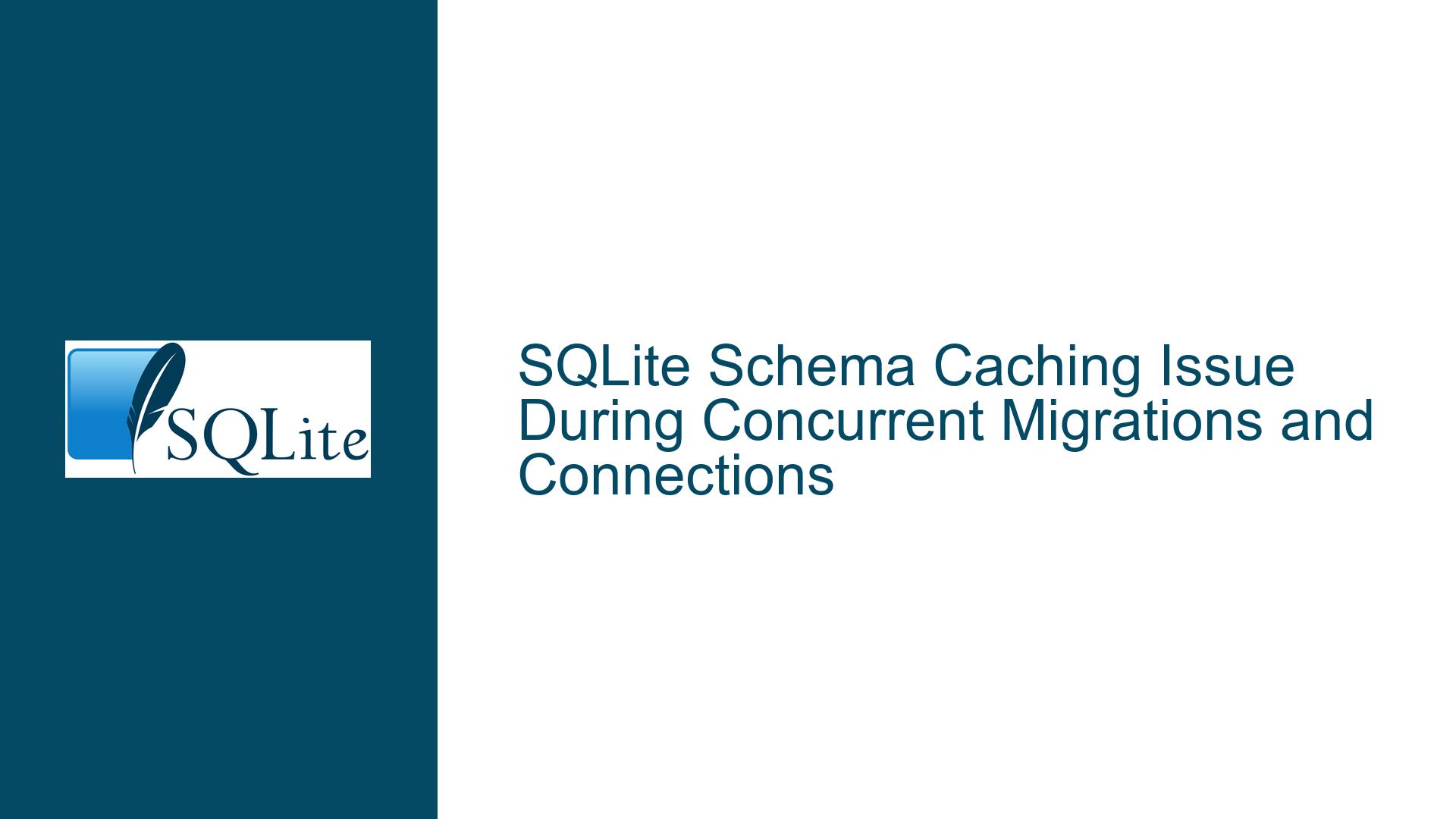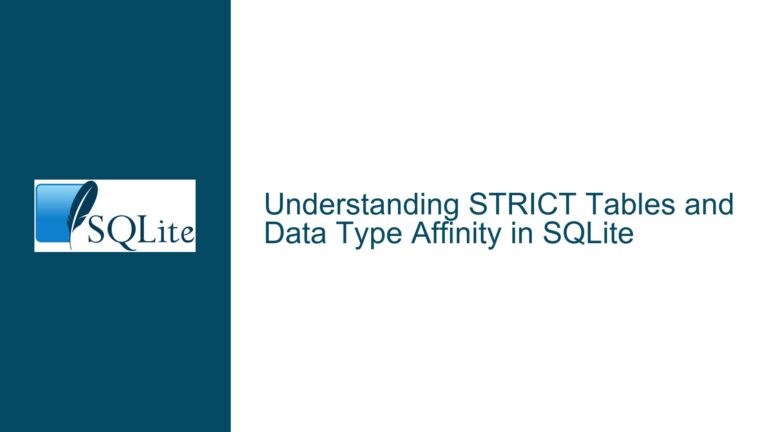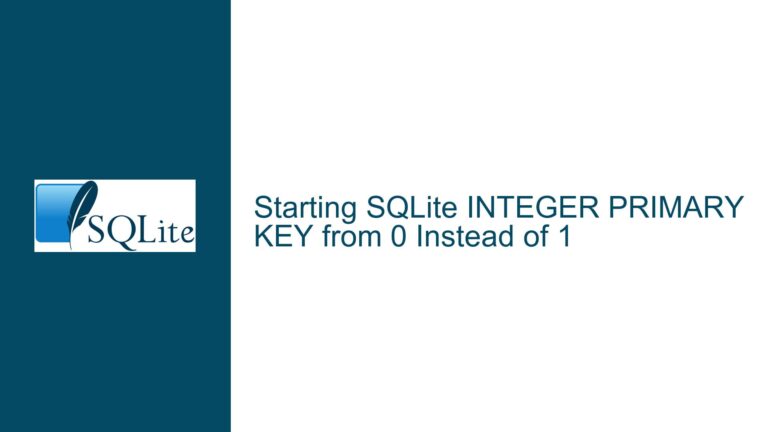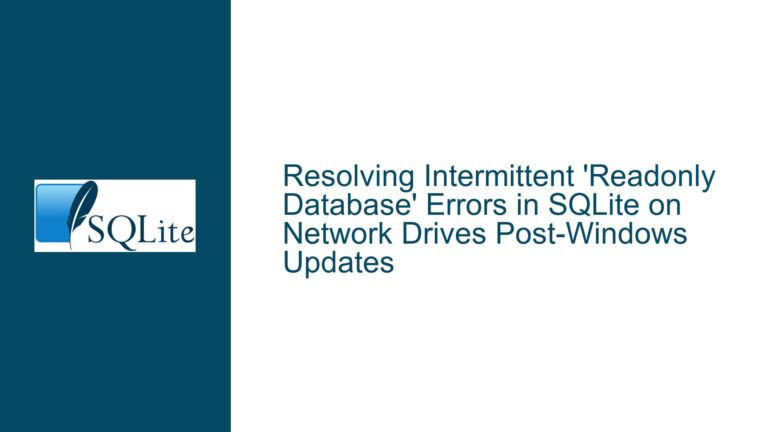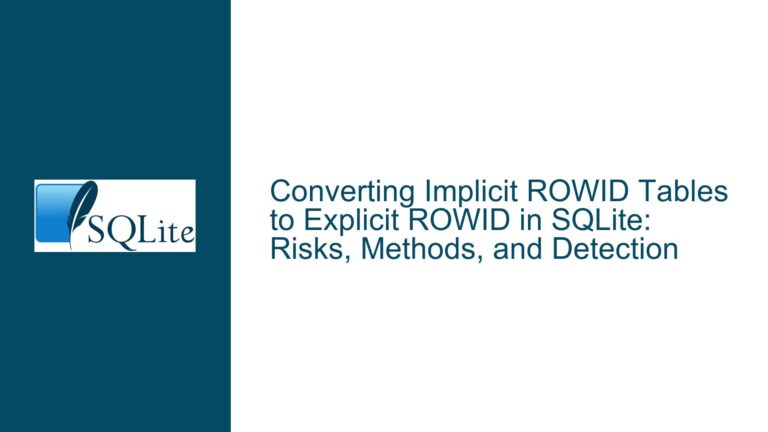SQLite Schema Caching Issue During Concurrent Migrations and Connections
Schema Caching and Migration Challenges in Multi-Connection Environments
SQLite is renowned for its lightweight, serverless architecture, making it a popular choice for embedded systems and applications requiring local data storage. However, its simplicity can sometimes lead to unexpected behavior, especially in complex scenarios involving schema migrations and concurrent connections. One such scenario arises when multiple connections access a database concurrently, and schema changes are applied through migrations. The core issue revolves around SQLite’s schema caching mechanism, which does not automatically refresh across all connections when schema changes occur. This can lead to inconsistencies, particularly when a view is replaced with a table of the same name, and connections continue to operate with outdated schema information.
This post delves into the intricacies of this issue, exploring its root causes, potential implications, and actionable solutions. By understanding the underlying mechanics of SQLite’s schema caching and migration processes, developers can implement robust strategies to ensure schema consistency across all connections, even in highly concurrent environments.
Understanding Schema Caching and Migration Workflows
SQLite maintains an in-memory cache of the database schema for each connection. This cache is used to optimize query planning and execution, as parsing and validating the schema for every query would be prohibitively expensive. However, this caching mechanism can lead to issues when the schema changes, as the cache is not automatically invalidated across all connections. This behavior becomes particularly problematic in applications that perform schema migrations, especially when multiple connections are involved.
In the described scenario, the application performs a series of migrations, including the removal of a view named XXX and the creation of a table with the same name. The unit test, which uses a connection created before the migration, continues to operate with the cached schema, leading to errors when attempting to interact with the newly created table. The test fails because the connection still believes XXX is a view, not a table.
The migration workflow in the application involves several steps:
- Opening a database connection with specific flags (
SQLITE_OPEN_CREATE | SQLITE_OPEN_READWRITE | SQLITE_OPEN_FULLMUTEX) and setting pragmas such asjournal_mode = PERSISTandforeign_keys = ON. - Reading database metadata, including the version and UUID stored in a one-row table.
- Checking if the application’s expected database version is higher than the version stored in the database.
- Applying migrations sequentially until the database version matches the application version.
Each migration is executed within its own transaction to ensure isolation. However, the schema cache for connections created before the migration is not automatically updated, leading to the observed inconsistencies.
Root Causes of Schema Caching Issues
The primary cause of the schema caching issue lies in SQLite’s design philosophy, which prioritizes performance and simplicity over automatic schema synchronization across connections. When a schema change occurs, SQLite updates the on-disk schema but does not propagate these changes to the in-memory caches of existing connections. This behavior is by design, as forcing schema reloads across all connections would introduce significant overhead, especially in high-concurrency environments.
Several factors exacerbate this issue in the described scenario:
- Concurrent Connections: The application uses multiple connections, some of which are created before the migration. These connections retain the old schema in their cache, leading to inconsistencies.
- View-to-Table Replacement: Replacing a view with a table of the same name is a particularly tricky scenario. Views and tables are fundamentally different entities in SQLite, and the schema cache does not handle such transitions gracefully.
- Custom VFS: The application uses a custom Virtual File System (VFS) based on Qt 5.12, which has known issues with flushing and syncing data to disk. While this is not directly related to the schema caching issue, it adds complexity to the overall system and may introduce additional edge cases.
- Lack of Schema Invalidation Mechanism: SQLite does not provide a built-in mechanism to force schema cache invalidation across all connections. While operations like
VACUUMcan achieve this, they are too heavyweight for frequent use, especially in performance-critical applications.
Strategies for Ensuring Schema Consistency
Addressing schema caching issues requires a combination of proactive measures and targeted fixes. Below are several strategies to ensure schema consistency across all connections during and after migrations:
1. Schema Version Management
SQLite provides the PRAGMA schema_version and PRAGMA user_version mechanisms to track schema changes. Incrementing the schema version after each migration can serve as a signal to connections that the schema has changed. However, this approach requires each connection to explicitly check the schema version and reload the schema if necessary. While this is not a fully automated solution, it provides a lightweight way to manage schema updates.
2. Connection Pool Management
The application uses a connection pool to manage database connections. After a migration, the pool can be configured to refresh all connections by closing and reopening them. This ensures that each connection operates with the latest schema. While this approach introduces some overhead, it is more efficient than running VACUUM after each migration.
3. Schema Reload Triggers
SQLite does not automatically reload the schema cache, but developers can manually trigger a reload using specific queries. For example, executing SELECT 1 FROM sqlite_master LIMIT 1; or PRAGMA user_version; forces SQLite to check the schema and update the cache if necessary. This approach can be integrated into the application’s migration workflow to ensure that all connections are updated.
4. Transaction Isolation and WAL Mode
The application currently uses journal_mode = PERSIST, which limits concurrent access during migrations. Switching to Write-Ahead Logging (WAL) mode can improve concurrency but introduces additional complexity. In WAL mode, readers and writers can operate simultaneously, but schema changes still require careful handling. Developers must ensure that schema changes are compatible with ongoing queries or interrupt and recompile prepared statements as needed.
5. Avoiding View-to-Table Transitions
Replacing a view with a table of the same name is a risky operation that can lead to schema caching issues. Where possible, developers should avoid such transitions by using distinct names for views and tables. If renaming is unavoidable, thorough testing is essential to identify and address any inconsistencies.
6. Custom Schema Invalidation Logic
For applications with complex requirements, custom logic can be implemented to manage schema invalidation. This might involve maintaining a list of active connections and triggering schema reloads as needed. While this approach requires significant development effort, it provides fine-grained control over schema updates.
Conclusion
Schema caching issues in SQLite can be challenging to diagnose and resolve, especially in applications with complex migration workflows and multiple concurrent connections. By understanding the root causes of these issues and implementing targeted strategies, developers can ensure schema consistency and maintain the reliability of their applications. Key takeaways include:
- SQLite’s schema caching mechanism does not automatically update across all connections, leading to potential inconsistencies.
- Incrementing the schema version, refreshing connection pools, and manually triggering schema reloads are effective strategies for managing schema updates.
- Avoiding risky operations like view-to-table transitions and leveraging SQLite’s transaction isolation features can further mitigate schema caching issues.
By adopting these best practices, developers can harness the power of SQLite while minimizing the risks associated with schema migrations and concurrent access.
